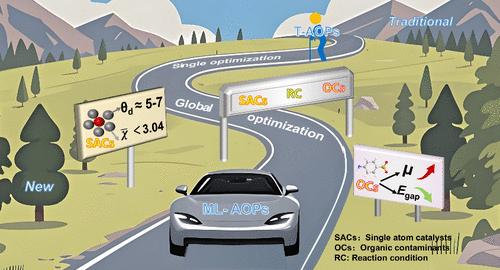机器学习驱动的单原子催化高级氧化过程全局优化
IF 11.3
1区 环境科学与生态学
Q1 ENGINEERING, ENVIRONMENTAL
引用次数: 0
摘要
单原子催化剂(SACs)是最先进的高级氧化过程(AOPs)净化水污染物。虽然以前的研究已经探索了单个影响因素,如中心金属种类和配位环境、反应条件或污染物分子性质,但这些变量对AOP动力学和热力学的综合影响仍然知之甚少。在这里,我们提出了一种基于全局优化策略的机器学习模型,该模型利用随机森林模型高精度地预测污染物降解性能。中心金属的d电子数和配位环境的平均电负性是决定AOP性能的关键描述符。理论计算,包括电荷密度分布、吸附能、投射态密度和晶体轨道汉密尔顿居群指标,揭示了这些描述符与过氧单硫酸盐活化能之间的强线性关系。全局优化分析表明,最优催化剂配置要求金属具有5-7 d电子,配位环境平均电负性小于3.04。此外,污染物特性显著影响降解性能。具体而言,当能隙小于3.92 eV且偶极矩大于7 d时,有机物的污染物降解速度更快。该研究为有效的aop净化系统的sac智能设计提供了一条机器学习指导的途径。本文章由计算机程序翻译,如有差异,请以英文原文为准。

Machine Learning-Driven Global Optimization of Single-Atom Catalyst-Mediated Advanced Oxidation Processes
Single-atom catalysts (SACs) are state-of-the-art for advanced oxidation processes (AOPs) for purifying water contaminants. While previous studies have explored individual influencing factors, such as the central metal species and coordination environment, reaction conditions, or contaminant molecular properties, the combined effects of these variables on AOP kinetics and thermodynamics remain poorly understood. Here, we propose a machine learning model based on a global optimization strategy that leverages a random forest model to predict pollutant degradation performance with high accuracy. The d electron number of the central metal and the average electronegativity of the coordination environment are identified as key descriptors in determining AOP performances. Theoretical calculations, including charge density distribution, adsorption energy, projected density of states, and crystal orbital Hamilton population metrics, reveal strong linear relationships between these descriptors and peroxymonosulfate activation energy. Global optimization analysis reveals that the optimal catalyst configuration requires metals possessing 5–7 d electrons, combined with coordination environments with average electronegativity values below 3.04. In addition, contaminant characteristics significantly affect degradation performances. Specifically, faster pollutant degradation is realized for organics with energy gaps below 3.92 eV and dipole moments greater than 7 D. This study offers a machine learning-guided pathway for intelligent design of SACs for effective AOP-based purification systems.
求助全文
通过发布文献求助,成功后即可免费获取论文全文。
去求助
来源期刊

环境科学与技术
环境科学-工程:环境
CiteScore
17.50
自引率
9.60%
发文量
12359
审稿时长
2.8 months
期刊介绍:
Environmental Science & Technology (ES&T) is a co-sponsored academic and technical magazine by the Hubei Provincial Environmental Protection Bureau and the Hubei Provincial Academy of Environmental Sciences.
Environmental Science & Technology (ES&T) holds the status of Chinese core journals, scientific papers source journals of China, Chinese Science Citation Database source journals, and Chinese Academic Journal Comprehensive Evaluation Database source journals. This publication focuses on the academic field of environmental protection, featuring articles related to environmental protection and technical advancements.
 求助内容:
求助内容: 应助结果提醒方式:
应助结果提醒方式:


